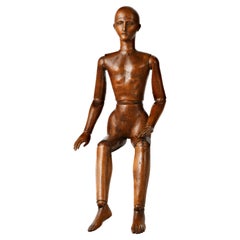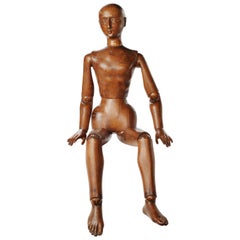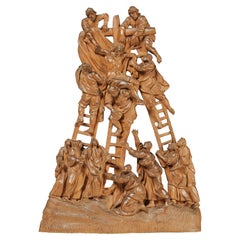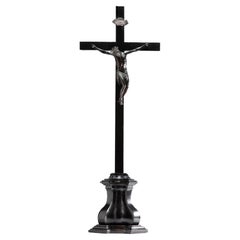Want more images or videos?
Request additional images or videos from the seller
1 of 21
20th Century Wood and Painted Plaster Czech Mushroom Botanical Models circa 1920
$12,041.86List Price
About the Item
- Dimensions:Height: 5.52 in (14 cm)Width: 4.34 in (11 cm)Depth: 1.97 in (5 cm)
- Sold As:Set of 34
- Style:Other (Of the Period)
- Materials and Techniques:
- Place of Origin:
- Period:1910-1919
- Date of Manufacture:circa 1920
- Condition:Minor structural damages. Minor fading. Some crack repaired and small defects on the labels.
- Seller Location:Milano, IT
- Reference Number:1stDibs: LU4352214321831
About the Seller
4.3
Vetted Professional Seller
Every seller passes strict standards for authenticity and reliability
Established in 1860
1stDibs seller since 2018
21 sales on 1stDibs
Associations
International Confederation of Art and Antique Dealers' Associations
Authenticity Guarantee
In the unlikely event there’s an issue with an item’s authenticity, contact us within 1 year for a full refund. DetailsMoney-Back Guarantee
If your item is not as described, is damaged in transit, or does not arrive, contact us within 7 days for a full refund. Details24-Hour Cancellation
You have a 24-hour grace period in which to reconsider your purchase, with no questions asked.Vetted Professional Sellers
Our world-class sellers must adhere to strict standards for service and quality, maintaining the integrity of our listings.Price-Match Guarantee
If you find that a seller listed the same item for a lower price elsewhere, we’ll match it.Trusted Global Delivery
Our best-in-class carrier network provides specialized shipping options worldwide, including custom delivery.You May Also Like
Early 20th century French Plaster Nativity Scene Figurines signed Marron, 1920s
Located in LEGNY, FR
Very nice and rare 20th century French set of plaster nativity scene figurines.
Twelve pieces are representing the religious nativity characters and the animals.
Large dimensions. ...
Category
Vintage 1920s French Figurative Sculptures
Materials
Plaster
$3,082 Sale Price / set
20% Off
H 16.15 in Dm 5.52 in
Emile Deyrolle 19th Century Plaster, Wire and Wood Didactic Germination Models
By Emile Deyrolle
Located in Buffalo, NY
LES FILS D'EMILE DEYROLLE, PARIS. Extremely rare set of four 19th century French painted plaster, wire and wood Didactic models depicting progression, ANATOMIE VEGETALE, beautifully ...
Category
Antique Late 19th Century French Folk Art Models and Miniatures
Materials
Wire
$12,500 / set
H 14.5 in W 12 in D 12 in
Mid-20th Century Hide and Wood Game Paddle
Located in Atlanta, GA
A leather and wooden gaming paddle from the mid-20th century. This vintage game paddle from India features a wooden handle and droplet-shaped body which has been wrapped in stretched...
Category
Mid-20th Century Indian Mounted Objects
Materials
Metal
20th Century Carved Wood Religious Figure, 'Joseph' Italy
Located in Buffalo, NY
Recently salvaged from old Downtown Buffalo New York church rectory, lifesize carved wood statue, "Joseph" which once adorned the vestibule, well executed, wonderful detail, great si...
Category
Vintage 1930s Italian Baroque Revival Religious Items
Materials
Wood
19th Century Botanic Model by Robert Brendel - Barley
By Robert Brendel
Located in Berghuelen, DE
19th Century Botanic Model by Robert Brendel - Barley
A rare antique botanical model manufactured by the famous Robert Brendel manufactory for botanicals models around 1900. Highly ...
Category
Early 20th Century German Mid-Century Modern Natural Specimens
Materials
Plaster, Wood, Paper
19th Century Botanic Model by Robert Brendel - Grain Grate
By Robert Brendel
Located in Berghuelen, DE
19th Century Botanic Model by Robert Brendel - Grain Grate
A great antique botanical model manufactured by the famous Robert Brendel manufactory for botanicals models around 1900. H...
Category
Early 20th Century German Mid-Century Modern Natural Specimens
Materials
Plaster, Wood, Paper
19th Century Botanic Model by Robert Brendel - Bean Seedling
By Robert Brendel
Located in Berghuelen, DE
19th Century Botanic Model by Robert Brendel - Bean Seedling
A rare antique botanical model manufactured by the famous Robert Brendel manufactory for botanicals models around 1900. ...
Category
Early 20th Century German Mid-Century Modern Natural Specimens
Materials
Plaster, Wood, Paper
Early 20th Century Model Ship Diorama Within a Bottle, circa 1920
Located in Central England, GB
A Most Interesting Early 20th Century Model Ship Diorama within Bottle.
This very well modelled and highly detailed model ship diorama within an early spirit bottle dates to circa...
Category
20th Century English Models and Miniatures
Materials
Wood, Glass
20th Century French Painted and Gilt Statue of Jesus Christ, Sacred Heart
Located in Miami, FL
This beautiful statue of Christ was crafted in Spain, circa 1900. The statue features the religious figure standing in a traditional seating pose a...
Category
20th Century Spanish Baroque Religious Items
$1,880
H 14 in W 9.5 in D 9.5 in
Plaster Model of Male Bust with Markings, France, 19th Century
Located in Kastrup, DK
Plaster bust on base. Preliminary study for marble carving with markings for the stonemason.
France, 1850-1880.
A very decorative piece.
Category
Antique Late 19th Century French Busts
Materials
Plaster
More From This Seller
View All19th Century Italian Wood Mannequin, Circa 1870-1880
Located in Milano, IT
Mannequin
Sculpted and carved wood
Italy or France, second half of the 19th century.
It measures 25.59 x 6.29 x 3.54 in (65.5 x 16 x 9 cm)
It weighs 2.2 lb circa (1 kg circa)
St...
Category
Antique 1870s Italian Other Figurative Sculptures
Materials
Wood
Late 19th Century Italian Wood Mannequin, circa 1880
Located in Milano, IT
Atelier mannequin
graven and carved stone pine wood
Italy, late 19th century
Measures: H 102 cm x 25 cm x 14 cm
H 40.15 in x 9.84 in x 5.51 in
Weight: circa kg 4
State of conse...
Category
Antique 1880s Italian Other Figurative Sculptures
Materials
Wood
Ancient Boxwood Micro Carving Deposition, First Half of the 18th Century
Located in Milano, IT
Boxwood micro carving
Deposition
Central Europe, first half of the 18th century
It measures: the sculpture 7.40 x 5.31 x 0.6 in (18.8 x 13.5 x 1.6 cm); w...
Category
Antique 1740s European Baroque Figurative Sculptures
Materials
Boxwood
Crucifix, Bronze, iron, and wood, Lombardy, mid-17th century
Located in Milano, IT
Crucifix
Lombardy, mid-17th century
Bronze, iron, and wood
Sculpture: 33 cm height x 35 cm width x 10 cm depth at the knees;
Cross: 42.12 in height x 19.68 in width (107 cm x 50);
Ba...
Category
Antique Mid-17th Century Italian Baroque Figurative Sculptures
Materials
Bronze, Iron
19th Century Italian Sterling Silver Madonna, circa 1830
Located in Milano, IT
Embossed and engraved silver plaque
La Madonna del lago (The Madonna of the Lake)
Probably Milan, post 1824
Brass frame
It measures 16.14 in x 13.85 in (41 x 35.2 cm) and it weighs 10.357 pounds (4.698 g): silver 1.31 pounds (598 g) + brass 9.03 pounds (4.100 g)
State of conservation: some abrasions on the bottom. The frame is old, but not original.
The plaque is made up of a sheet of embossed and engraved silver, and held in a solid brass frame. It depicts the “Madonna del lago” – “Madonna of the Lake” - (the Madonna with Child and San Giovannino) by Marco d'Oggiono (Oggiono, 1474 circa - Milan, 1524 circa), while changing only the background landscape. Almost certainly the subject reproduced in the plaque was taken from a famous engraving by Giuseppe Longhi (Monza, 1766 - Milan, 1831), one of the greatest engravers of his era.
The silver is unmarked, probably because originally the Madonna was due to be exposed in a church: sometimes precious metals destined for worship and liturgical use would be exempted from payment and were, therefore, not marked.
It is very likely that the plaque was made in Milan because in this city in 1824 the engraving by Giuseppe Longhi was made and printed. In addition, in Milan, the alleged lost painting by Leonardo da Vinci in his Milanese period (1482-1500) would be produced; this is the painting from which Marco d'Oggiono took his version.
The painting
Marco d?Oggiono was one of Leonardo da Vinci's most brilliant students and collaborators (D. Sedini, Marco d’Oggiono, tradizione e rinnovamento in Lombardia tra Quattrocento e Cinquecento, Roma 1989, pp. 151-153, n. 56; p. 225, n. 124, with previous bibliography). His style reflects in every way that of the Tuscan Maestro, so much so that he was the one who executed some copies of da Vinci's paintings. The execution of the “Madonna del Lago” probably draws inspiration from a lost painting by the Maestro, created while he was living in Milan (1482-1500). There are many similarities with other works by Leonardo such as the “Vergine delle rocce” or the “Vergine con il Bambino e San Giovannino, Sant’Anna e l’Agnello”.
The painting, from which the drawing and then the famous engraving were taken, is found today at the M&G Museum of Bob Jones University in Greenville, South Carolina, where it came to rest after the sale of the Harrington Collection in London in 1917.
The work appears in the inventories of the collection of Napoleon and Joséphine Bonaparte at the castle of Malmaison, before 1809.
The Malmaison building was born and developed in the 17th and 18th centuries. In the 18th century it belonged to Jacques-Jean Le Coulteux du Molay, a wealthy banker. Later, during the Directory, Joséphine Bonaparte de Beauharnais bought it on April 21st, 1799, but settled at the castle definitively only after her husband separated from her in 1809. She remained there until 1814, the year of her death. When Joséphine died, the estate passed to her son Eugène de Beauharnais, who moved to Munich with his whole family in 1815, bringing with him the collection of paintings he inherited from his mother. Eugène died in 1824 and his wife Augusta of Bavaria (von Bayern), unable to keep it, in 1828 sold the Malmaison to the Swedish banker Jonas-Philip Hagerman.
It is likely that in this period Augusta also sold part of the paintings inherited from her husband, including the “Madonna del Lago”. This painting then came into the possession of Leicester Stanhope, fifth Earl of Harrington (1784 - 1862) and then was passed down to his descendants.
In 1917, at the death of Charles, eighth Earl of Harrington, his brother Dudley inherited the title and properties and he put up a part of his collections for sale. Among these, precisely, the painting by Marco d'Oggiono was to be found.
On the occasion of that auction the painting was presented as a work by Cesare da Sesto, by virtue of a handwritten note by the Countess of Harrington on the back of the table. However, already in 1857, the German critic Gustav Waagen had identified Marco d'Oggiono as the author of the painting, then exhibited in the dining room of Harrington House in London (Treasures of Art in Great Britain, in 4 volumes, London, 1854 and 1857).
The engraving
Giuseppe Longhi was one of the most renowned engravers in Italy between the end of the 18th century and the first quarter of the 19th century.
In 1824 Giuseppe Longhi, based on a design by Paolo Caronni, made a famous engraving of the painting of Marco d?Oggiono. The activity of Longhi was then at the peak of his notoriety, enough to earn him very substantial commissions; it is not risky to suppose that some of his successful engravings were also reproduced using other means: in our case in silver. (A. Crespi, a cura di, Giuseppe Longhi 1766–1831 e Raffaello Morghen...
Category
Antique 1820s Italian Neoclassical Sterling Silver
Materials
Sterling Silver, Brass
German Globe by C. Abel-Klinger, Nuremberg, circa 1860
By C. Abel-Klinger
Located in Milano, IT
Terrestrial globe
Artistic company C. Abel - Klinger
Nuremberg, circa 1860
H cm 31 x 22 cm (12.20 x 8.66 in); sphere 14 cm (5.51 in) in diameter
lb 2.30 (kg 1.04)
State of conservation: good. On the sphere there are slight visible signs of accidental bumping at the poles, as well as on New Guinea and England (vertical and more visible); some ink stains, especially at the South Pole and on the meridian that crosses North America.
The globe is composed of twelve whole gores of printed paper, juxtaposed and glued on a sphere made with a chalky base mixture.
The circle of the meridian, made of brass...
Category
Antique 1860s German Other Scientific Instruments
Materials
Wood, Paper



